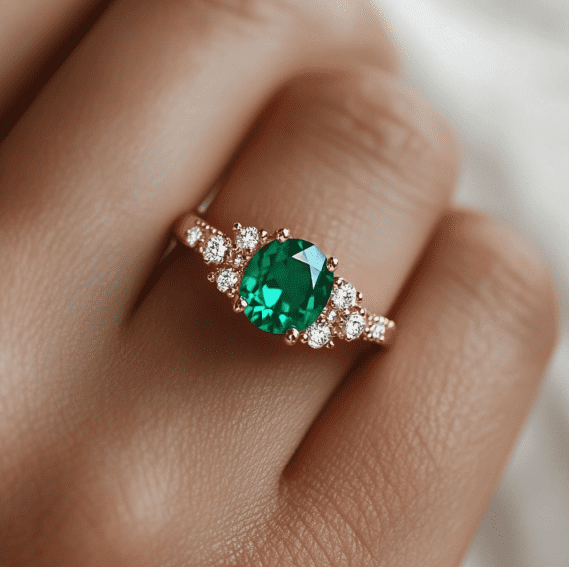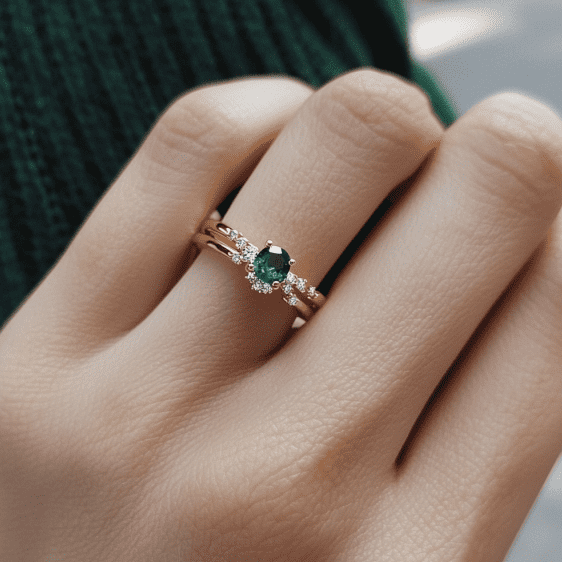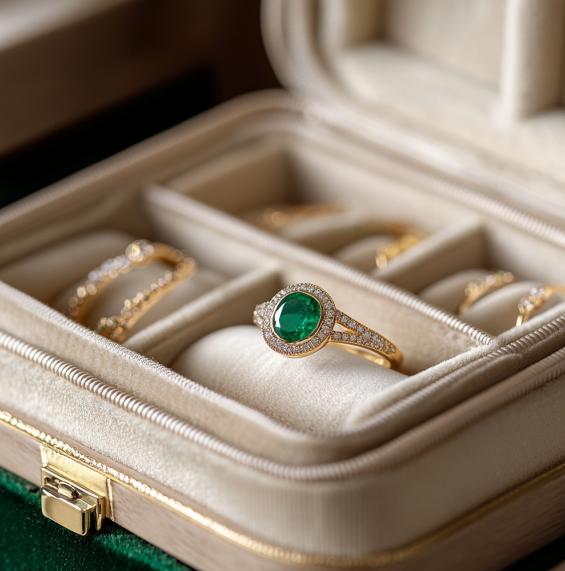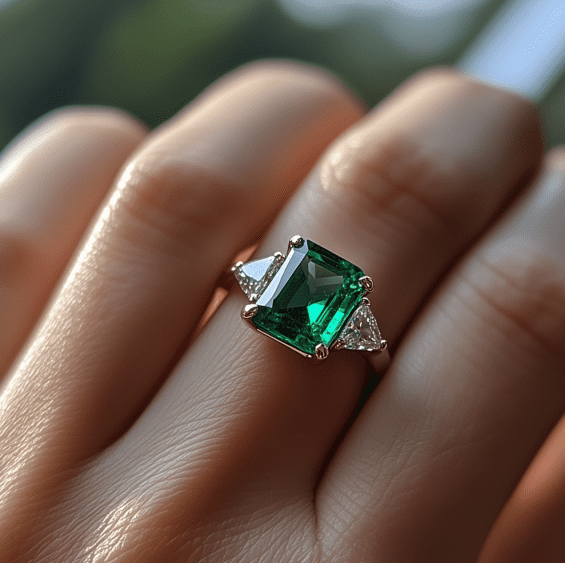Emerald Ring
Elegance, History, and How to Choose the Perfect One
Emerald Ring: What’s the Best Cut to Enhance Its Beauty?
The emerald ring is renowned for its distinctive green hue and timeless elegance. For centuries, it has been treasured by royalty, celebrities, and jewellery lovers around the world. However, choosing the best cut to highlight an emerald’s beauty is no simple task. Unlike diamonds, which have more standardised cuts, emeralds require specific cutting techniques to maximise their colour, brilliance, and durability. In this article, we’ll explore the different cuts for emeralds and which is best suited to bring out the beauty of this fascinating gemstone.
- Emerald Cut: The Classic Favourite
When we talk about emerald rings, the most popular and closely associated cut with this gemstone is, without doubt, the emerald cut. This type of cut is rectangular with step-like facets along the edges, allowing the stone to showcase its deep green colour and clarity.
The emerald cut is not only visually striking but also functional. It helps protect the stone from potential damage, as emeralds tend to be more fragile than other gemstones like diamonds. This cut highlights the purity of the emerald and allows light to flow gently through the stone, creating a soft, sophisticated glow.
- Round Cut: Versatility and Sparkle
The round cut, also known as the brilliant round, is one of the most common cuts in the world of gemstones and can be an excellent option for an emerald ring. While it’s more typical for diamonds, this cut works well with emeralds due to its symmetry and ability to reflect light.
The round cut maximises the emerald’s sparkle, but it often results in more material loss during the cutting process, making it a less frequent choice for smaller or lower-quality stones. However, for those seeking an emerald ring with spectacular shine and a classic shape, the round cut can be an excellent choice.
- Oval Cut: Vintage-Style Elegance
The oval cut is ideal for those looking for an emerald ring with a vintage touch. This cut is similar to the round cut in its ability to maximise brilliance, but its elongated shape gives the emerald a more elegant and refined appearance.
One of the benefits of the oval cut is that it creates the illusion of a larger stone, making it perfect for those who want a striking ring without significantly increasing the carat weight. Additionally, this cut works well in both classic and modern settings, making it a versatile choice to enhance the beauty of the emerald.
- Pear Cut: A Unique and Romantic Touch
The pear cut, with its teardrop shape, is a less common but equally stunning choice for an emerald ring. This cut combines the characteristics of the round and marquise cuts, with a pointed end on one side and a smooth curve on the other.
The pear cut is ideal for those seeking a unique and romantic design. It can also make the wearer’s finger look longer and more slender, adding a touch of sophistication. However, due to the fragility of emeralds, it’s important to ensure that the pointed end of the pear cut is well-protected with a prong or suitable setting to avoid damage.

- Princess Cut: Modern and Full of Sparkle
The princess cut is another popular choice for those seeking a modern and dazzling emerald ring. This square or rectangular cut, with multiple facets, is known for its ability to reflect light spectacularly, enhancing the stone’s brilliance.
However, since emeralds are more fragile than diamonds, the princess cut can be more prone to chipping at the corners unless a protective setting is used. Despite this challenge, many choose the princess cut for its modern style and its ability to highlight the emerald’s intense green colour.
- Cushion Cut: A Timeless Classic
The cushion cut, or cushion shape, is a blend of the round and princess cuts, giving it a square shape with rounded edges. This cut has been used for centuries and is a popular choice for those seeking an emerald ring with a vintage, romantic touch.
The cushion cut maximises light dispersion, which enhances the colour of the emerald and gives it a soft, elegant appearance. It’s an ideal choice for those who prefer a ring with a traditional look but an updated design.
Conclusion
When it comes to choosing the best cut for an emerald ring, it all depends on personal style and the stone’s inherent beauty. The emerald cut is a favourite for its ability to highlight the purity of the emerald, while cuts like the oval, pear, and cushion offer elegant and eye-catching options. Whatever the choice, a good cut will maximise the ring’s brilliance, colour, and durability, showcasing the natural beauty of the emerald.
Why Choose an Emerald Ring as an Engagement Ring?
The emerald ring has gained popularity in recent years as a unique and meaningful option for an engagement ring. While diamonds are often the traditional choice, many couples are choosing emeralds for their rich history, unique beauty, and deep symbolism. This article explores the reasons why you should consider an emerald ring as your engagement ring.
- Symbolism and Meaning of Emeralds
One of the main reasons to choose an emerald ring is the profound symbolism this gemstone holds. Throughout history, emeralds have been associated with love, wisdom, and hope. In many ancient cultures, emeralds were believed to encourage loyalty and fidelity, making them an ideal choice for an engagement ring.
Additionally, emeralds are seen as stones of renewal and growth, symbolising the beginning of a new life together. Their vibrant green colour evokes images of nature, freshness, and eternal life, which can resonate deeply in a relationship that’s committed and continuously evolving.
- A Unique Alternative to Diamonds
An emerald ring is a distinctive and alternative choice for those who want something outside the traditional. While diamond rings have been popular for over a century, emeralds offer a refreshing option that stands out in a crowd.
Each emerald has unique characteristics, including inclusions or “jardins,” which give it personality and character. These inclusions aren’t seen as flaws but rather as marks that tell the stone’s story. For those who value individuality and uniqueness, an emerald may be far more appealing than a perfectly clear diamond.
- History and Connection with Royalty
Emeralds boast a rich history and have been prized by royalty for centuries. Cleopatra, the legendary queen of Egypt, was known for her love of emeralds, adorning herself with them in many of her jewels. In medieval Europe, monarchs often gifted emeralds as symbols of power and wealth.
Even in modern times, emeralds are appreciated by royalty. The British royal family, for example, has several iconic pieces featuring emeralds, adding a touch of elegance and status to this choice. Choosing an emerald ring as an engagement ring connects you with this rich tradition and brings an air of nobility and distinction to your jewellery.

- Unique Colour and Beauty
The deep green colour of an emerald is undoubtedly one of this gemstone’s most captivating features. Unlike diamonds, whose appeal lies in their clarity and sparkle, emeralds capture attention with their vibrant colour and mystical appearance.
Emeralds range from lighter shades to intense, deep greens, each with its own charm. This colour is not only striking but also has a calming and rejuvenating effect. For couples seeking a stone that symbolises peace, balance, and harmony, an emerald ring is a perfect choice.
- Versatility in Design
Another reason to choose an emerald ring is its versatility in design. Emeralds suit a wide range of styles, from classic and timeless to modern and bold. You could opt for a traditional emerald cut that emphasises the stone’s clarity, or select a more contemporary design with geometric shapes that showcase its originality.
Emeralds also pair beautifully with different metals. White gold or platinum provides an elegant contrast to the green of the emerald, while yellow gold adds a warm, vintage touch. This flexibility allows you to personalise the ring to suit your taste, making it truly unique.
- Sustainability and Social Responsibility
In recent years, many couples have started to consider sustainability and ethics when choosing engagement jewellery. Emeralds, particularly those from Colombia, are valued for their responsible sourcing and minimal environmental impact. By choosing an emerald ring, you’re not only selecting a gemstone of extraordinary beauty but also supporting ethical and sustainable mining practices.
Today, many emerald mines operate with a focus on social responsibility and respect for local workers and communities. Choosing an emerald can be a way to ensure your engagement ring aligns with your ethical values.
Conclusion
Choosing an emerald ring as an engagement ring is a choice filled with meaning, beauty, and distinction. From its rich history and symbolism to its unique colour and ability to stand out among traditional rings, emeralds offer a different, special option for those who want their engagement ring to tell a unique story. Additionally, an emerald ring can reflect values of sustainability and social responsibility, adding even greater significance to this choice.
How to Care for and Maintain Your Emerald Ring for a Lifetime
An emerald ring is a precious and enduring piece of jewellery that, with proper care, can stay in perfect condition for a lifetime. However, emeralds require more delicate handling than other gemstones, such as diamonds, due to their internal structure and chemical composition. To ensure your emerald ring retains its sparkle and beauty over time, it’s important to follow specific care and maintenance practices. In this article, we explain how to care for and maintain your emerald ring to keep it a dazzling piece of jewellery.
- Regular and Gentle Cleaning of Your Emerald Ring
One of the most essential aspects of caring for your emerald ring is regular cleaning. Since emeralds can accumulate dirt and dust over time, frequent cleaning is key to maintaining their shine. However, it’s crucial to carry out this process carefully.
To clean your emerald ring at home, follow these steps:
- Fill a bowl with warm water and add a few drops of mild hand soap or non-abrasive detergent.
- Place the ring in the water and let it soak for a few minutes to loosen any built-up dirt.
- Use a soft-bristled toothbrush to gently clean the emerald and the band. Avoid applying too much pressure, as emeralds can be more fragile than other gemstones.
- Rinse the ring with clean warm water and dry it with a soft, lint-free cloth.
It’s important to avoid using ultrasonic cleaners or harsh chemicals on emeralds, as these can damage the stone or its natural inclusions.
- Avoiding Knocks and Physical Damage
Unlike diamonds, emeralds have a lower hardness on the Mohs scale, making them more prone to knocks and physical damage. Emeralds have what is known as “jardins” or natural inclusions, which give them character but can also make them more vulnerable to chipping or cracking if struck.
To protect your emerald ring, avoid wearing it during activities involving intensive manual work, such as gardening, sports, or any task that could put the stone at risk. It’s also advisable to remove your ring before using tools or harsh chemicals.
- Proper Storage of Your Emerald Ring
When not wearing your emerald ring, it’s essential to store it properly to prevent scratching or damage. Emeralds can be scratched if they come into contact with harder gemstones or metals, such as diamonds.
Store your ring in a padded jewellery box or a soft fabric pouch to prevent contact with other pieces of jewellery. If possible, keep each emerald ring or piece of jewellery stored separately to minimise the risk of damage.

- Avoid Exposure to Extreme Temperatures
Emeralds are sensitive to temperature changes, so it’s essential to protect your ring from extreme heat or cold. Very high or low temperatures can cause emeralds to crack or become damaged. This is particularly important if your emerald ring has been treated with oils or resins—a common procedure to enhance its appearance—as heat can damage these treatments.
Avoid leaving your emerald ring exposed to sunlight for prolonged periods, and remove it before entering saunas, hot baths, or any activity that involves sudden temperature changes.
- Periodic Professional Inspection
Despite the care you can provide at home, it’s recommended to take your emerald ring to a professional jeweller at least once a year for inspection and deeper cleaning. An experienced jeweller can check the ring setting to ensure that the emerald is secure and not at risk of coming loose.
Additionally, a professional can perform a thorough cleaning to remove any grease or dust build-up that household methods can’t tackle. If the emerald has been treated with oils, the jeweller can also reapply these oils to maintain the stone’s brightness and clarity.
- Avoid Contact with Chemicals
Harsh chemicals, such as household cleaners, perfumes, hairsprays, and creams, can dull an emerald’s lustre and damage its internal structure. When using these products, make sure to remove your emerald ring to avoid contact with the stone.
It’s best to apply perfumes and lotions before putting on your ring to prevent chemical residues from settling on the stone. With this small precaution, you’ll help preserve the bright and vibrant look of your emerald for longer.
Conclusion
An emerald ring is a precious piece of jewellery that, with proper care, can last a lifetime and even become a family heirloom passed down through generations. Regular cleaning, avoiding physical damage, proper storage, and periodic professional check-ups are essential steps to ensure your ring retains its beauty. With these simple measures, your emerald ring will continue to shine and symbolise love and commitment for years to come.
History of the Emerald Ring: A Symbol of Wealth and Power
The emerald ring has been valued throughout history as a symbol of wealth, power, and beauty. From ancient times to the present, emeralds have been prized not only for their captivating green hue but also for the symbolism and status they represent. This fascinating gemstone has adorned emperors, queens, and leaders from various cultures, solidifying its place as one of the world’s most coveted gems. In this article, we explore the rich history of the emerald ring and how it has come to symbolise power and prestige across different eras and civilisations.
- Ancient Egypt: Cleopatra and Her Love for Emeralds
One of the most legendary figures associated with emeralds is Queen Cleopatra of Egypt. Cleopatra was known for her fascination with emeralds and her use of them in royal jewellery. Egypt was, in fact, one of the earliest major sources of emeralds, with mines dating back to around 330 BC. The emeralds extracted from these mines were used to adorn crowns, rings, and other luxury objects.
For Cleopatra, the emerald ring symbolised not only her power as a ruler but also her beauty and wealth. Emeralds were believed to possess mystical properties, such as granting wisdom and protection to those who wore them. This made the emerald ring a powerful symbol of authority within the Egyptian court.
- Roman Empire: Emeralds as Protective Amulets
During the Roman Empire, emeralds continued to be valued for their beauty and supposed healing and protective properties. The Romans believed that emeralds could improve vision and provide mental clarity. Due to these beliefs, it was common for Roman leaders and high-ranking figures to wear emerald rings as protective amulets.
The deep green colour of emeralds was associated with fertility and nature, giving it special significance in a culture that valued connection with the natural world. Emperors and other members of the Roman elite wore emeralds not only as jewellery but also as a way of demonstrating their wealth and power.
- Middle Ages: A Symbol of Wisdom and Royalty
In the Middle Ages, the emerald ring gained even more significance in European courts. European royalty and nobility wore emeralds as symbols of divine power, wisdom, and wealth. Emeralds were considered precious stones that could ward off misfortune and evil spirits and were believed to promote fidelity and loyalty in relationships.
During this period, emerald rings were commonly exchanged as symbols of marital and political alliances. The nobility used these gems not only as ornaments but also as markers of their social standing. The emerald ring became a prestigious gift that demonstrated the wealth and status of its wearer.

- Renaissance: The Emerald as a Royal Gemstone
During the Renaissance, the emerald ring reached a new level of popularity among European monarchs. With the expansion of trade routes to Latin America, particularly Colombia, high-quality emeralds began to flood the European market. Colombian emerald mines, discovered by Spanish conquistadors in the 16th century, produced stones of superior quality, making them even more desirable.
Monarchs like Elizabeth I of England and Marie Antoinette of France wore emerald rings as symbols of their wealth and power. The emerald ring became a key piece in royal jewellery collections, worn on special occasions such as coronations and state ceremonies. Its intense green colour, associated with royalty and divinity, reinforced the image of monarchs as powerful, almost divine figures.
- Victorian Era: Emeralds in Sentimental Jewellery
During the Victorian era, the emerald ring continued to be a symbol of luxury but also took on sentimental significance. Queen Victoria of England was known for her love of emeralds, and many of the rings she wore included this precious stone in their design. Emeralds began to be used in engagement jewellery and commemorative pieces, giving them a new meaning as symbols of eternal love.
The use of emeralds in engagement rings also became popular in this era, as the stones symbolised fidelity and renewal. Emeralds were considered heart stones, making them ideal for promises of love.
- Emeralds Today: A Symbol of Distinction
Today, the emerald ring remains a symbol of luxury, distinction, and power. Although diamonds are often the most common choice for engagement rings, emeralds have gained popularity among those seeking something unique and steeped in history. Their rich heritage and association with royalty and power make the emerald ring a sophisticated and prestigious choice for those who desire jewellery that represents more than mere beauty.
Modern celebrities and public figures like Angelina Jolie and Beyoncé have worn stunning emerald rings at important events, contributing to the increased visibility of this gemstone in the world of fashion and high jewellery.
Conclusion
The emerald ring has been, throughout history, a symbol of wealth, power, and timeless beauty. From Cleopatra to European monarchs and today’s public figures, the emerald has adorned the hands of those who wish to project an image of distinction and prestige. Its unique beauty, combined with its rich history, ensures that the emerald ring remains one of the world’s most coveted pieces of jewellery.
For more information, visit here
